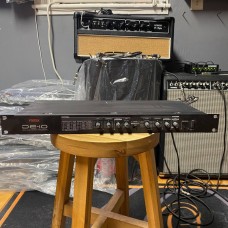Pre-Owned Fostex DE-10 Digital Effects
- Product Code: Pre-Owned Fostex DE-10 Digital Effects
- Availability: 1
-
$100.00
Pre-Owned Fostex DE-10 Digital Effects
***This is a pre-owned item in good condition.
The unashamedly entry-level Fostex DE10 delivers a slightly different take on the 'pick a patch, pick a variation' type of preset-based effects processor, in that it offers true dual-channel (mono-in, stereo-out) operation as well as a stereo-in, stereo-out single mode that may also be used mono-in. In dual mode, different effects can be selected for the two channels and the two sections behave more or less as two independent effects units. In addition, the first channel may be switched between line and guitar/mic input levels, and in single mode the unit includes both amplifier and mic modelling alongside the expected effects.
Unusually for a budget effects unit, this 1U unit is mains powered and is finished in a shade of purple more often associated with HHB than Fostex. Input conversion is 20-bit with the output conversion at 24-bit, yielding a dynamic range of around 92dB and a frequency response of 20Hz to 20kHz. There's no MIDI and no programmability, which keeps things simple from the operation standpoint, and level metering is restricted to a peak LED that comes on 6dB before clipping.
Each of the channels is controlled by just four knobs, with a centrally mounted slide switch to select between a Dual mode and two Single modes. The first knob chooses the basic effect algorithms, while the second provides 11 variations of each effect. A third knob adjusts one key parameter (which varies according to the type of effect) while the fourth control adjusts the wet/dry balance. An effects mute button is located to the right of the panel, close to the mains switch, and the spare panel space to the left of the unit is used to display a list of the effect algorithms. So far then, a very familiar entry-level format.
In the Single modes, instead of the spare knobs (the second channel's Parameter and Mix knobs) being disarmed, they are redeployed to extend the user controls to three parameters per patch, where the overall wet/dry balance is controlled by the Mix knob on the first channel. As all the processing power is available in Single mode, the algorithms also tend to be more complex than in Dual mode. When Dual mode or the first Single mode are selected, the available effects are the same (but with more parameter control and better reverb density in Single mode), but in the second Single mode, all but the first four reverb algorithms are new and include numerous guitar effects as well as mic modelling.
All signal jacks are unbalanced on the rear panel, and include two sets of stereo outputs, mic/guitar and line inputs for channel one and a line input for channel two. All three input sockets have gain trim controls on the rear panel. Channel one includes a slide switch to select between the line or mic/guitar input jacks, the latter being designed for use with high-impedance mics or electric guitars. A further jack socket provides a means to mute the effect part of the signal using an optional footswitch.



